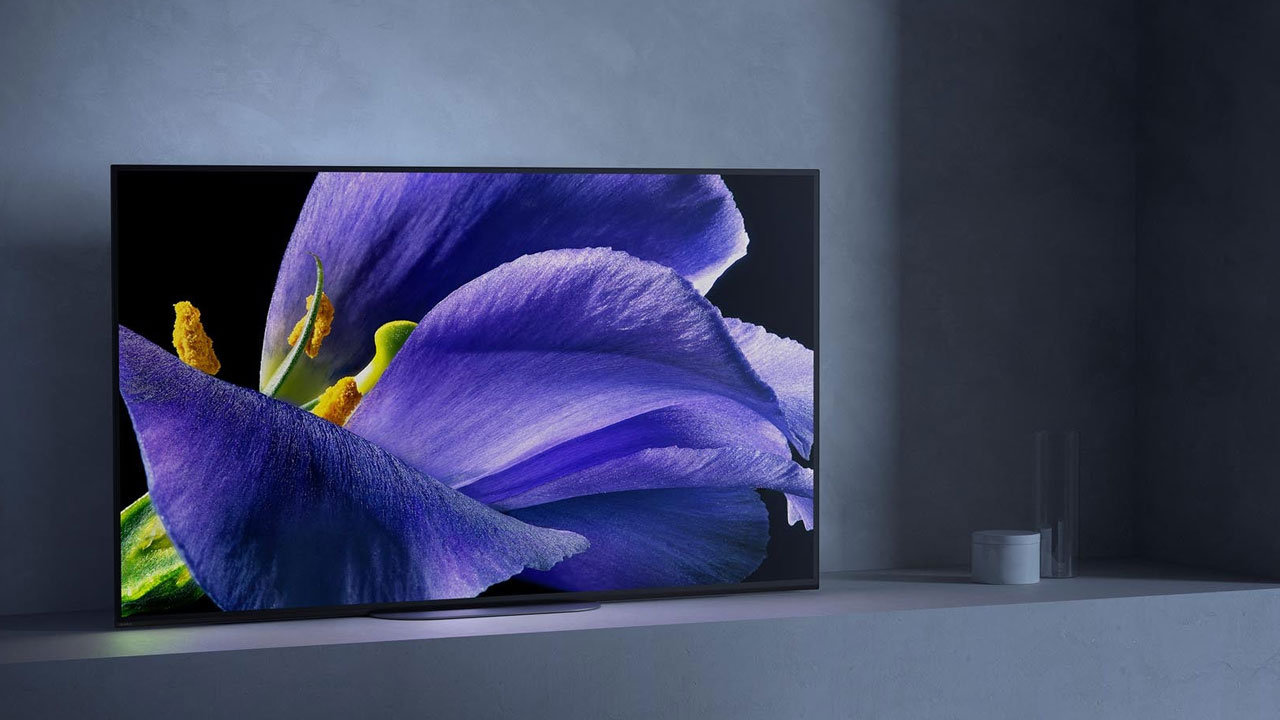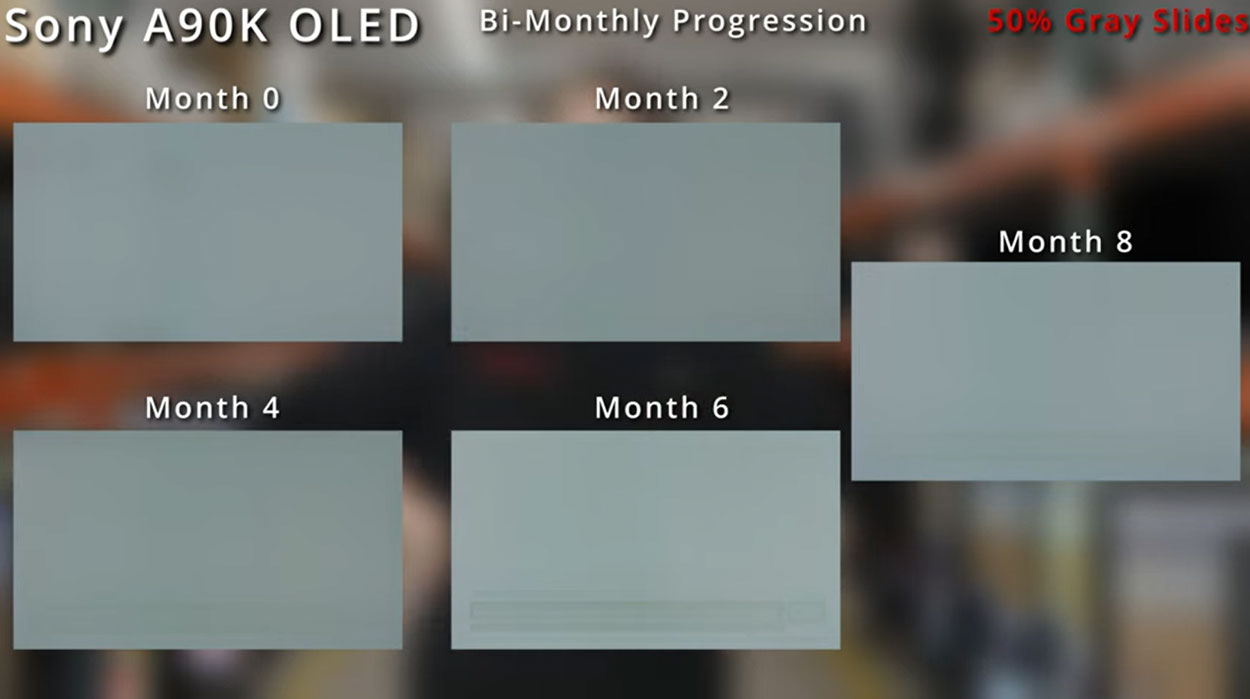OLED TV Burn-in Testing Reinvestigated Due to Settings Inconsistencies
YouTube video from RTINGs overturns some of its previous Sony OLED TV burn-in conclusions.

Concerns about OLED burn-in are alive and well in 2023. However, some findings published earlier in the year included errors regarding OLED burn-in severity, particularly with Sony TV models. A new video from consumer electronics testing specialists RTINGS (pronounced ‘ratings’) seeks to clear up any confusion and delivers an update on its long-term OLED TV testing process.
To recap, the large testing project RTINGS is running has over 100 modern OLED TVs playing CNN for an average of 18 hours per day. This is intended to “simulate 10 years of usage in just two years.”
There is some important background information to consider when observing or measuring OLED burn-in. Two other image problems are seen on OLED TVs, which look a lot like burn-in but are usually temporary and fixable. This "temporary image retention" can quickly occur in modern OLED TVs, but manufacturers have built-in features to stop it from impacting your viewing pleasure.
Firstly, temporary image retention can happen due to heat build-up in the panel, and turning off and resting the TV will typically clear it, which is pretty simple.
Secondly, and much more complicated, TFT layer image retention can occur, and it looks like OLED burn-in. Modern OLED TVs periodically run a 'short compensation cycle' to remove this type of image retention. However, each manufacturer uses a different name for this tech and implements the scheduling and other related options differently. Usually, when the TV is off, it will run a 'short compensation cycle' for about 10 mins. In technical terms, this functionality will "detect and compensate for changes in the TFT layer's electrical characteristics and return it to a baseline state."
RTINGS found these short compensation cycle functions worked pretty well across brands. Sadly, some TVs do this housekeeping in a buggy way and don't allow for simple manual prompting.
LG models run the firm's "pixel clean" cycle immediately after you turn the TV off, as long as it has been running for a cumulative 4 hours since the last time it was switched off. LG TVs launched since 2022 have also included the ability to manually begin a "pixel clean" cycle.
Get Tom's Hardware's best news and in-depth reviews, straight to your inbox.
Samsung OLED TVs are said to follow the same 4-hour policy as LG but were less consistent in applying it, according to RTINGS' testing. Some Samsung models worked as expected, while others were "a mystery." However, manually un/plugging the set seemed to force a short compensation cycle should the user think one is needed.
RTINGs observed that Sony's approach is even less consistent than Samsung's. The cumulative time between recalibration ranges from four to six or more hours, depending on the Sony OLED TV model. Timing differences seem to be intentional, backed up by RTINGS testing observations, so they must be design changes implemented between Sony TV series.
Sony also tends to run its short compensation cycles several hours after the TV has been turned off. Sony said it delayed the image retention clearing function so it didn't disrupt households with the 'click sound' from the process starting. You can manually trigger this process on Sony TVs, but it requires fiddling deep in the Sony TV OSD menus.
Sony OLED Reassessment
Previous Sony OLED comments from RTINGS mentioned that the image retention may have been “early onset burn-in,” but now that it has figured out Sony’s peculiar scheduling, the testing site admits it was wrong.
The site now says that most of the image degradation in the picture above in ‘Month 6’ was TFT layer image retention. Things are now improved in ‘Month 8’ since it got to grips with Sony’s weird recalibration cycle timings. Thus, what you see in ‘Month 8’ is actually “Electroluminescent Layer Degradation” or Permanent Burn-In of the OLED panel. In brief, Sony OLEDs don’t look so bad for burn-in anymore.
During its 100 OLED TVs testing, RTINGs has also noted a PSU failure, two motherboard replacements, two screens showing lines of dead pixels, one TV died due to a boot loop and couldn’t be repaired (needed replacement), and another was destroyed during the repair process (oops).
It is also commented that CNN thoughtlessly changed its logo/position, so tests since 2017 are no longer directly comparable with newer tests.
Lastly, PC enthusiasts will probably be pleased to know that RTINGs has inserted some OLED monitors into its torture test: the Dell Alienware AW3423DWF, Samsung Odyssey OLED G8/G85SB S34BG85, and LG 27GR95QE-B. It asks for those interested to stay tuned for longer-term findings. Some new 2023 TVs were also added; hopefully, they are more reliable, as the manufacturers claim.

Mark Tyson is a news editor at Tom's Hardware. He enjoys covering the full breadth of PC tech; from business and semiconductor design to products approaching the edge of reason.
-
hotaru.hino Testing the QD-OLED panels in the monitors has me curious if only because the OLED part of it is a single color that excites the QD part. While that doesn't mean much in terms of burn-in, it may present different behavior than a straight OLED panel.Reply
However, after using a Mini LED panel for a few months now, I don't think I'll be looking at OLED panels for a while. Sure there's a little bit of haloing here and there, but a lot of times it really does feel like I'm looking at an OLED panel even in a dark room. Doubly so if HDR content is running. -
helper800 Reply
Mini-LEDs are brighter with imperfect blacks, and have some haloing. OLEDs are dimmer but have perfect contrast with a chance of permanent burn-in. I personally went with OLED because the haloing from Mini-LEDs drives me insane, and the room I have it in is usually dark so peak brightness is less of an issue. Both technologies look amazing either way.hotaru.hino said:Testing the QD-OLED panels in the monitors has me curious if only because the OLED part of it is a single color that excites the QD part. While that doesn't mean much in terms of burn-in, it may present different behavior than a straight OLED panel.
However, after using a Mini LED panel for a few months now, I don't think I'll be looking at OLED panels for a while. Sure there's a little bit of haloing here and there, but a lot of times it really does feel like I'm looking at an OLED panel even in a dark room. Doubly so if HDR content is running. -
SirWired FWIW, I'm pretty sure that a couple firmware updates ago, Sony moved the recalibration cycle to only occur in the middle of the night. My A80J used to click randomly in the middle of the afternoon if we watched something in the AM, and now it no longer does that. (I suspect a lot of people were wondering if their TV was posessed.) I can guess that they simply moved the recal cycle to when most people are asleep.Reply -
Alvar "Miles" Udell When manufacturers are confident enough in their OLED panels to warranty them parts and labor for 10 years, I'll consider them. LG is getting there with a 5 year parts-only warranty on their TVs, but if I'm to spend $1500+ on a higher end TV, I want guarantees it'll actually last.Reply -
Kamen Rider Blade Reply
The issue with Samsung's QD-OLED panels is that their panels use only Red & Green Quantum Dots while the Blue OLED passes through un-obstructed w/o any Quantum Dots.hotaru.hino said:Testing the QD-OLED panels in the monitors has me curious if only because the OLED part of it is a single color that excites the QD part. While that doesn't mean much in terms of burn-in, it may present different behavior than a straight OLED panel.
However, after using a Mini LED panel for a few months now, I don't think I'll be looking at OLED panels for a while. Sure there's a little bit of haloing here and there, but a lot of times it really does feel like I'm looking at an OLED panel even in a dark room. Doubly so if HDR content is running.
So effectively, the panel is a pure Blue OLED panel underneath the QD layer.
So OLED burn-in will happen since part of the Blue OLED will always shine through, and any static image that uses Blue in it will slowly show itself as the RTings burn-in test has shown.
my1lyUE7WVM
This is why I think the "Ultimate" Display Panel tech would be a Violet SED Panels with a RGB QD Layer over it using a standard Hexagonal Color Matrix like old school CRTs.
Maximum Color Emission using the Violet Color since that has the highest electron-Volt value to excite the QD layer.
-
Friesiansam Just buy LCD, such as Samsung QLED. Still excellent picture but, none of the OLED problems.Reply
Simple.
